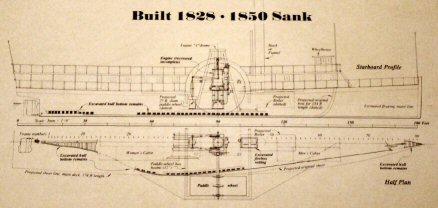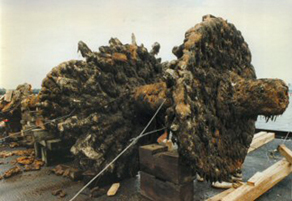Curator's Choice 2008
Columbus Paddle Wheel
April 2008
By Kathy Concannon, MAC Lab Educator
 In 1991 and 1992, underwater archaeologists investigated a shipwreck located in 60 feet of water in the Chesapeake Bay near Smith Point,
Virginia. The subsequent study of significant features of the wreck, including a massive 22 foot paddle wheel, confirmed the identity
of the vessel as the Steam Ship Columbus, which burned and sank in the early morning hours of November 28, 1850 while carrying passengers, crew, and cargo.
In 1991 and 1992, underwater archaeologists investigated a shipwreck located in 60 feet of water in the Chesapeake Bay near Smith Point,
Virginia. The subsequent study of significant features of the wreck, including a massive 22 foot paddle wheel, confirmed the identity
of the vessel as the Steam Ship Columbus, which burned and sank in the early morning hours of November 28, 1850 while carrying passengers, crew, and cargo.
The Columbus was traveling from Baltimore to Richmond with 16 people on board when, at approximately 3 a.m., a draft through
the steamboat's smokestack caused fire to burst out of the furnace. The flames spread very rapidly. Only seven of the passengers survived.
They climbed into the only lifeboat that was not cut off by the flames and then watched through binoculars as the Columbus
continued to burn and drift. At 11 a.m., it finally disappeared from view (Irion and Beard 1995).
 At the time of the Columbus' sinking, steamboats were already having an impact on America's economy. Unlike sailing vessels, steamboats
were largely unaffected by currents and winds. Commerce had begun to rely on the dependable shipping schedules that steamboat companies
were able to establish. The Columbus was one of the first steamboats to navigate the Chesapeake Bay and was well known in
the Chesapeake area. Her main purpose was to carry freight between Baltimore and Norfolk, but she also occasionally carried passengers.
One of the Columbus' most distinguished passengers was the renowned Native American leader Black Hawk. Black Hawk, along with other Native Americans, was transported
to Norfolk on the Columbus to view the gunship Delaware, which had been recently completed at the Norfolk Navy Yard (Emmerson 1949).
At the time of the Columbus' sinking, steamboats were already having an impact on America's economy. Unlike sailing vessels, steamboats
were largely unaffected by currents and winds. Commerce had begun to rely on the dependable shipping schedules that steamboat companies
were able to establish. The Columbus was one of the first steamboats to navigate the Chesapeake Bay and was well known in
the Chesapeake area. Her main purpose was to carry freight between Baltimore and Norfolk, but she also occasionally carried passengers.
One of the Columbus' most distinguished passengers was the renowned Native American leader Black Hawk. Black Hawk, along with other Native Americans, was transported
to Norfolk on the Columbus to view the gunship Delaware, which had been recently completed at the Norfolk Navy Yard (Emmerson 1949).
Discovering the wreck of the Columbus gave archaeologists a rare opportunity to study a vessel that operated in the first years of the Steam
Age. The significant features of the wreck that aided in identifying it as the SS Columbus -- the crosshead engine and enormous
paddle wheel -- had been newly developed after 20 years of  improvements
in steam engineering. The Columbus' engine is the only recovered crosshead engine in the United States. Because of the limited information about this important early engine type, the
cylinder, crank, and starboard paddle-wheel were recovered from the wreck site for conservation and further study. Conservation of the artifacts was completed in January 1998, after more than six years and 6,000
hours of treatment. Traditional conservation techniques had to be modified in order to treat the paddle wheel, which is estimated to weigh 15,000 lbs (International Artifact Conservation 1998).
In January 1998, the artifacts were returned to Maryland and now reside at the Maryland Archaeological Conservation Laboratory.
improvements
in steam engineering. The Columbus' engine is the only recovered crosshead engine in the United States. Because of the limited information about this important early engine type, the
cylinder, crank, and starboard paddle-wheel were recovered from the wreck site for conservation and further study. Conservation of the artifacts was completed in January 1998, after more than six years and 6,000
hours of treatment. Traditional conservation techniques had to be modified in order to treat the paddle wheel, which is estimated to weigh 15,000 lbs (International Artifact Conservation 1998).
In January 1998, the artifacts were returned to Maryland and now reside at the Maryland Archaeological Conservation Laboratory.
| References |
|
| Emmerson, John C., Jr. |
| 1949 |
he Steamboat Comes to Norfolk Harbor. Edwards Brothers, Ann Arbor. |
|
| International Artifact Conservation and Research Laboratory, Inc. |
| 1998 |
Conservation Treatment Report, Paddle-wheel Steamboat COLUMBUS, Engine Components and Miscellaneous Artifacts. Belle
Chasse, Louisiana. Report on file at the Maryland Archaeological Conservation Laboratory. |
|
| Irion, Jack B. and David V. Beard |
| 1995 |
Data Recovery on the Wreck of the Steamship Columbus, 18ST625, St. Mary's County, Maryland. Report Prepared for U.S. Army Corps of Engineers, Baltimore, Maryland. |
|